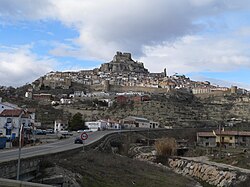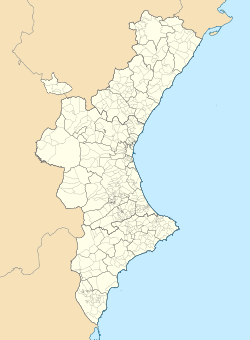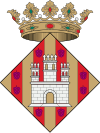Morella, Castellón
Morella | ||
|---|---|---|
 Panoramic view of Morella, Ports | ||
| ||
 Morella in Els Ports | ||
 Morella Location of Morella in Spain Show map of Province of Castellón  Morella Morella (Valencian Community) Show map of Valencian Community  Morella Morella (Spain) Show map of Spain | ||
| Coordinates: 40°37′10.60″N 0°06′06.20″W / 40.6196111°N 0.1017222°W / 40.6196111; -0.1017222Coordinates: 40°37′10.60″N 0°06′06.20″W / 40.6196111°N 0.1017222°W / 40.6196111; -0.1017222 | ||
| Country | ||
| Autonomous community | ||
| Province | ||
| Comarca | Els Ports | |
| Government | ||
| • Alcalde | Rhamsés Ripollés (PSPV-PSOE) | |
| Area | ||
| • Total | 413.5 km2 (159.7 sq mi) | |
| Elevation | 984 m (3,228 ft) | |
| Population (2016) | ||
| • Total | 2,504 | |
| • Density | 6.1/km2 (16/sq mi) | |
| Time zone | UTC+1 (CET) | |
| • Summer (DST) | UTC+2 (CEST) | |
| Website | www.morella.net/ | |
| Morella is in the heart of the historic region of Maestrazgo | ||
Morella is an ancient walled city located on a hill-top in the province of Castellón, Valencian Community, Spain. The town is the capital and administrative centre of the comarca of Els Ports, in the historic Maestrat (Maestrazgo) region.
There are traces of settlement by the Iberians, succeeded by the Greeks and Romans, Visigoths and the Moors. From the early 17th century to the Spanish Civil War, the town was often fought over, due to its strategic situation between the Ebro and the coastal plain of Valencia. Morella is part of the Taula del Sénia free association of municipalities.
Every six years the citizens celebrate the Sexenni, a commemoration of the town's recovery from the plague in the seventeenth century. Tourism now plays an important part in the local economy, along with agriculture. In the 20th century the town and surrounding area became depopulated, a trend that has only been reversed in the early 21st century. The population of Morella in 2008 was 2,854,[1] having declined from a figure of 7,335 in 1900 (INE).[2]
One of the typical gastronomic products of Morella is sweets known as flaons. Local bakeries are also renowned for a number of other traditional pastries and sweets, like mantecadas, prepared in the ancient way.
Contents
1 History
2 Sexenni
3 Municipal area
4 Geography
5 Today
6 Gallery
7 See also
8 References
9 External links
History

Municipal charter of Morella (1233).
Prehistoric remains in the area include cave paintings in Morella la Vella and Bronze Age graves at Hostal Nou. The Greeks established a treasury at Morella, but then the area became the scene of conflict between the Carthaginians and the Roman Empire during the Punic Wars. Eventually the town was Romanized and became part of the province of Tarragona.[3] The Moors took the town in 714, naming it Maurela.
El Cid is reputed to have rebuilt the castle which dominates the town and in 1084 he is supposed to have fought in the service of Yusuf al-Mu'taman ibn Hud and defeated Sancho Ramírez of Aragon at the Battle of Morella. In 1117, Sancho captured Morella, but it was recaptured by the Moors and only finally subdued by Blasco de Alagon in 1232. Following Blasco's death in 1239, James I of Aragon established a royal garrison in the city and awarded the inhabitants the title of "Faithful".[3]
Morella sided with Philip V during the War of the Spanish Succession in the early eighteenth century and became the centre of a military and political district. During the Napoleonic Wars, the citizens rose up against the invading forces and the town was finally captured for Spain in 1813 by Francisco Javier de Elío. In the Carlist Wars of the nineteenth century Morella became the headquarters of the forces of Ramon Cabrera.[3]
The town was captured by forces of General Franco in April 1938, towards the end of the Spanish Civil War. Republican guerillas held out in the surrounding mountains until 1956.[4][5]
In the 1960s and 70s many people left the town for work opportunities in the cities and many of the local small industries died, but a slow revitalization has taken place since the transition of Spain to democracy.[6]
Sexenni

Dance of Gitanetes, Sexenni 2012. Morella
In the late seventeenth century, Morella was severely affected by the plague. After twenty years of suffering, the citizens brought a statue of the Virgin Mary from the Sanctuary of Vallivana, 24 kilometres (15 mi) away, at the feet of the Serra de Vallivana range, and processed it through the streets. It is said that the plague disappeared from the city and, to remember this, every six years the Sexenni festival takes place for nine days in late August. The virgin is carried in procession and the traditional town guilds perform ancient dances in her honour. The festivities in 2006 were the first of the 21st century.[7]
Municipal area

Denes of Morella
Morella's municipal area is divided into subdivisions are known as Dena since ancient times.
These are: La Vespa, Els Castellons, Dena Primera del Riu, Dena Segona del Riu, La Font d'en Torres, Herbeset, Els Llivis, Morella la Vella, El Coll i el Moll, La Pobla d'Alcolea, Dena de la Roca, Muixacre, Herbeset, Xiva de Morella, Hortells and Vallivana.
Geography
Morella occupies a strategic position between the plains of the river Ebro to the north west and the coastal plains of Valencia and Castellon. Access from the north west lies through the passes of Torre Miró 1,259 metres (4,131 ft) and Querol 1,020 metres (3,350 ft). The old town is completely enclosed by 2.5 kilometres (1.6 mi) of ancient stone walls, pierced at seven points by gates or portals. The river Bergantes skirts the southern boundaries of the town as it descends towards the Guadalope which ultimately joins the Ebro.
The climate is high mountain Mediterranean, with cool summers and cold winters with frequent frosts and heavy snow. During the winter months the north east mistral, which often blows in this area, causes wind chill factors of as much as -20 °C.
Today
Morella is now a tourist destination, with many historic buildings, hotels and restaurants. It is listed as one of the most beautiful towns in Spain. Some of the top sights to see in Morella are the Castillo de Morella (Morella Castle), the aqueduct, La Iglesia de Santa María Morella (Saint Mary’s Church), Convento de San Francesc Morella (St. Francis’ Convent) and the Morella Museo Temps de Dinosaures (Time of Dinosaurs Museum Morella).
Although not as important as in the past, wool and woollen goods still plays a part in the local economy. One of its most famous products is the Morella blanket, which has a unique design, with a range of colour combinations and horizontal stripes. Agriculture, especially poultry and pig production are important in the surrounding area.with craft products and highly valued black truffles which are traded at seasonal markets during the winter.[8][9]
Gallery
Dance of the Llauradors, Sexenni, Morella 2006

Morella in 1845
Street in Morella
Gate of the Church Santa María la Mayor

Alabaster windows in Santa Maria La Major church
See also
- Ports (comarca)
- Ports de Morella
- Maestrat
- Vallivana
References
^ "Municipality: 080 Morella 2001-2008". Instituto Nacional de Estadística. Retrieved 2009-11-20..mw-parser-output cite.citationfont-style:inherit.mw-parser-output qquotes:"""""""'""'".mw-parser-output code.cs1-codecolor:inherit;background:inherit;border:inherit;padding:inherit.mw-parser-output .cs1-lock-free abackground:url("//upload.wikimedia.org/wikipedia/commons/thumb/6/65/Lock-green.svg/9px-Lock-green.svg.png")no-repeat;background-position:right .1em center.mw-parser-output .cs1-lock-limited a,.mw-parser-output .cs1-lock-registration abackground:url("//upload.wikimedia.org/wikipedia/commons/thumb/d/d6/Lock-gray-alt-2.svg/9px-Lock-gray-alt-2.svg.png")no-repeat;background-position:right .1em center.mw-parser-output .cs1-lock-subscription abackground:url("//upload.wikimedia.org/wikipedia/commons/thumb/a/aa/Lock-red-alt-2.svg/9px-Lock-red-alt-2.svg.png")no-repeat;background-position:right .1em center.mw-parser-output .cs1-subscription,.mw-parser-output .cs1-registrationcolor:#555.mw-parser-output .cs1-subscription span,.mw-parser-output .cs1-registration spanborder-bottom:1px dotted;cursor:help.mw-parser-output .cs1-hidden-errordisplay:none;font-size:100%.mw-parser-output .cs1-visible-errorfont-size:100%.mw-parser-output .cs1-subscription,.mw-parser-output .cs1-registration,.mw-parser-output .cs1-formatfont-size:95%.mw-parser-output .cs1-kern-left,.mw-parser-output .cs1-kern-wl-leftpadding-left:0.2em.mw-parser-output .cs1-kern-right,.mw-parser-output .cs1-kern-wl-rightpadding-right:0.2em
^ "De facto Population figures from 1900 until 1991 - De facto Population: Morella. Both sexes". Instituto Nacional de Estadística. Retrieved 2009-11-20.
^ abc
"Guía Virtual de la Comunidad Valenciana: Morella" (Spanish). Federacion Valenciana de Municipios y Provincias. Retrieved 2009-11-17.
^ Segarra Capsir, Francisco (2009). Los 'maquis' en el Maestrazgo (in Spanish). Castellón: Editorial Antinea. ISBN 978-84-96331-63-1.
[page needed]
^ "Las guerrillas de Teruel, Cuenca y Levante". camiloberneri.org (in Spanish). 13 May 2008. Retrieved 4 November 2010.
^
"Coneix la història de Morella: prehistòria, medieval, moderna i contemporània" (Valenciano). La ciutat de Morella. Retrieved 2009-11-17.
^
"Sexenni of Morella, Castellon". www.valenciatrader.com. Retrieved 2009-11-18.
^ "Gastronomy". Mancomunidad Turística del Maestrazgo. Retrieved 2009-11-17.
^ Lander, Nick. "Truffle hunting in Spain - 2001". www.nicklander.com. Retrieved 2009-11-18.
External links
| Wikimedia Commons has media related to Morella. |
| Wikivoyage has a travel guide for Morella. |
- Web oficial de l'ajuntament de Morella
- Paco González Ramírez, País Valencià, poble a poble, comarca a comarca
Institut Valencià d'Estadística.
Portal de la Direcció General d'Administració Local de la Generalitat.






